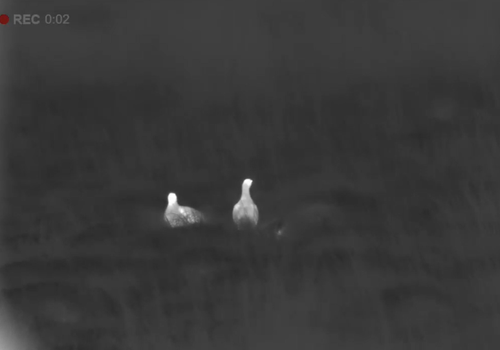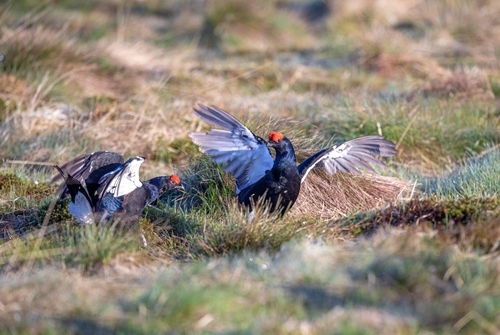Twenty black grouse have successfully been translocated from their stronghold in the North Pennines to the North York Moors by researchers from the Game & Wildlife Conservation Trust (GWCT) to help expand their range.
Ten hens and ten cocks were caught at night during November and early December, and immediately transported to the release site two hours’ drive away. This site had been specially selected for the birds as it provides the required mix of habitats for them.
The team used thermal binoculars, lamps and hand-held nets to capture the birds and 15 of them were fitted with radio transmitters to allow us to follow their settlement patterns, survival and lekking behaviour. The translocation was carried out under a licence from Natural England.

Dr Phil Warren, from GWCT and leading the project, says: “Initial visits to the North York Moors show that birds have settled in the vicinity of the release area.
“This is a really positive sign, and we will continue to monitor movements and survival over the winter months and through the breeding season to assess how they settle, survive and breed.
“The data will also help us decide if we will make any further releases, and if those will be done in the same area, or whether we try to find a second recipient site to help establish a network of inter-connected lekking groups.
Black grouse are a Red List species of high conservation concern. In England, they are now largely restricted to the North Pennines, which includes parts of County Durham, Northumberland, Cumbria and North Yorkshire. Here, numbers remain broadly stable, fluctuating between 1-2,000 displaying males over the last 25 years.
The North York Moors were selected following landscape-scale habitat improvements on the fringes of moorland managed for grouse shooting. Work carried out included removing conifer woodland and restoring the ground to bog, heath and scrub woodland. Moorland grasslands have also been managed more extensively to control bracken control and restore bilberry and heather.
Occasional females have been spotted here in recent years, but no breeding has been recorded. However it is hoped that the climate in the North York Moors, which is drier and warmer in June when chicks hatch, will also help the birds re-establish populations here.
Natural re-colonisation of black grouse to the North York Moors from the existing populations in the North Pennines is currently limited by the 30-km gap across unsuitable lowland farmland habitats in the Vale of Mowbray.

Credit: Emily Graham Media
Phil adds: “This translocation could not have been done without the invaluable help from the landowners and keepers at the donor sites, who have provided excellent support..
“Thanks to their efforts, and the help from the owners and keepers of the recipient sites, we hope to see black grouse established in the North York Moors.”
Led by researchers from the GWCT’s Uplands team and funded by £164,000 from Natural England’s Species Recovery Programme Capital Grant Scheme, the Black Grouse Range Expansion Project.
About black grouse (Lyrurus tetrix)
A grouse of moorland and forest edge, the black grouse is best known for its early morning spring-time gatherings, called ‘leks’, where the males gather to compete for females. They display by fanning out their elaborate, lyre-shaped tails and inflating their necks to signal their vigour and defend or claim their territory. Their song consists of a long, dove-like bubbling coo or murmur, The hens arrive at the lek to pick the overall healthiest male, which they will mate with.
Males are jet black with long, curved tail feathers. They have a slim white stripe in the wing and white feathers under the tail. Females are well camouflaged with finely barred brown and black plumage and have a cackling call. The female takes all responsibility for nesting and rearing the chicks.
Black grouse favour a mosaic of moorland habitats and marginal farmland that are near to woodland, and the species initially benefited from the planting of commercial forestry plantations following the Second World War. However, as these plantations matured, they have become unsuitable for the species. Changes in land management have taken a toll on the population in modern times.
Ends
Notes for editors:
The Game & Wildlife Conservation Trust – providing research-led conservation for a thriving countryside. The GWCT is an independent wildlife conservation charity which has carried out scientific research into Britain’s game and wildlife since the 1930s. We advise farmers and landowners on improving wildlife habitats. We employ more than 60 post-doctoral scientists and other research staff with expertise in areas such as birds, insects, mammals, farming, fish and statistics. We undertake our own research as well as projects funded by contract and grant-aid from Government and private bodies.
Natural England
- The Species Recovery Programme (SRP), which Natural England has been operating for more than thirty years, has helped to drive targeted action to reverse the fortunes of many of England’s most threatened species.
- The Programme has been enhanced through the new Species Recovery Programme Capital Grants Scheme (SRPCGS) launched in April 2023. An announcement of 63 successful projects was made by Natural England on 14 September 2023. Led by 46 organisations with a further 28 partners the total value of these SRPCGS grant awards is £14.5 million. 150 threatened species are being targeted to benefit from this investment over two financial years.
- The Species Recovery Programme is focused on reducing the risk of extinction and promoting the recovery of our most threatened species, especially through bespoke targeted action for these species. Through the SRP, Natural England works together with, and facilitates involvement from, a wide range of partner organisations to tackle the recovery of England’s threatened wildlife, working collaboratively to drive nature’s recovery.
For more information, images or to arrange an interview please contact:
Eleanor Williams
ewilliams@gwct.org.uk
07592 025476